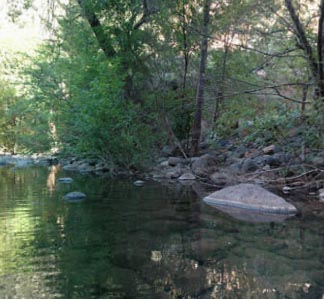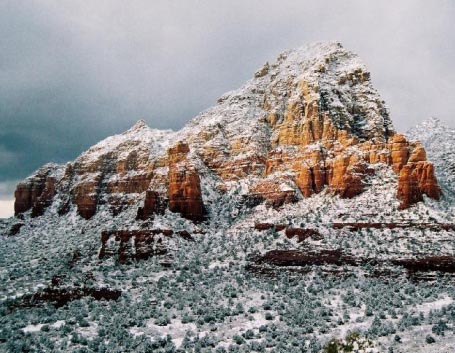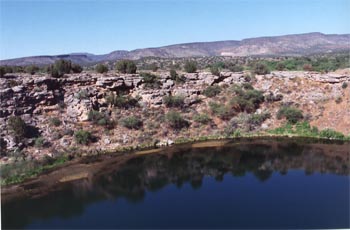Beaver Creek Biosphere Reserve | Conservation Lands
| Drought | Fire Ecology | Invasives | Sinagua Circle
Conservation Lands in Beaver Creek Watershed:
Wilderness Areas (Administered by the US Forest Service)
Wet Beaver Creek Wilderness
Click above to read a detailed description of this wilderness area from wilderness.net

Munds Mountain Wilderness
Click above to read a detailed description of this wilderness area from wilderness.net

The two wilderness areas above are part of the 107 million acre National Wilderness Preservation System. This System of lands provides clean air, water, and habitat critical for rare and endangered plants and animals. In wilderness, you can enjoy challenging recreational activities like hiking, backpacking, climbing, kayaking, canoeing, rafting, horse packing, bird watching, stargazing, and extraordinary opportunities for solitude. You play an important role in helping to "secure for the American people of present and future generations the benefits of an enduring resource of wilderness" as called for by the Congress of the United States through the Wilderness Act of 1964. Please follow the requirements outlined below and use Leave No Trace techniques when visiting the these wilderness areas to ensure protection of their unique wilderness characteristics and values. Visit www.wilderness.net or the Arizona Wilderness Coalition for more information about wilderness preservation.
Contact Info:
Coconino National Forest
Red Rock Ranger District
P.O. Box 300
Sedona, AZ 86339
Phone: 928-282-4119
Restrictions: Our office hours are 7:30 - 4:30, Monday through Friday
General Wilderness Prohibitions
Motorized equipment and equipment used for mechanical transport is generally prohibited on all federal lands designated as wilderness. This includes the use of motor vehicles, motorboats, motorized equipment, bicycles, hang gliders, wagons, carts, portage wheels, and the landing of aircraft including helicopters, unless provided for in specific legislation.
In a few areas some exceptions allowing the use of motorized equipment or mechanical transport are described in the special regulations in effect for a specific area. Contact the Forest Service office or visit the websites listed on the 'Links' tab for more specific information.
These general prohibitions have been implemented for all national forest wildernesses in order to implement the provisions of the Wilderness Act of 1964. The Wilderness Act requires management of human-caused impacts and protection of the area's wilderness character to insure that it is "unimpaired for the future use and enjoyment as wilderness." Use of the equipment listed as prohibited in wilderness is inconsistent with the provision in the Wilderness Act which mandates opportunities for solitude or primitive recreation and that wilderness is a place that is in contrast with areas where people and their works are dominant.
National Park Service Units
 Montezuma Castle Montezuma Castle
This five-level, 20 room cliff dwelling nestled into
a limestone recess high above Beaver Creek served
as a "high-rise apartment building" for prehistoric Sinagua Indians over 600 years ago. It is one of the
best preserved cliff dwellings in North America. Erroneously named for the 16th century Aztec ruler,
the site is a classic example of the last phase of southern Sinagua occupation of the Verde Valley.
National Park Service Mission:
The National Park Service preserves unimpaired the natural and cultural resources and values of the
national park system for the enjoyment, education,
and inspiration of this and future generations. The
Park Service cooperates with partners to extend the benefits of natural and cultural resource conservation and outdoor recreation throughout this country and the world. To explore conservation topics in relation to the National Park Service, click here.
Montezuma Well
Montezuma Well is a detached unit of Montezuma Castle National Monument located approximately 11 miles from the park. Take Exit 293 from I-17 and drive four miles. No entrance fee is charged. There is a one-third mile loop trail that is not recommended for wheelchair use.
 A lush, shaded picnic area is also located at the Well.Montezuma Well is a limestone sink formed long ago by the collapse of an immense underground cavern. Over one and a half million gallons of water a day flow continuously, providing a lush, verdant oasis in the midst of surrounding desert grassland. The waters of the well contain several forms of plant and animal life not found in any other waters of the world. This unique habitat is perhaps due to the constant input of large quantities of warm water that enter through underground springs, keeping the environment within the well very stable. A lush, shaded picnic area is also located at the Well.Montezuma Well is a limestone sink formed long ago by the collapse of an immense underground cavern. Over one and a half million gallons of water a day flow continuously, providing a lush, verdant oasis in the midst of surrounding desert grassland. The waters of the well contain several forms of plant and animal life not found in any other waters of the world. This unique habitat is perhaps due to the constant input of large quantities of warm water that enter through underground springs, keeping the environment within the well very stable.
Prehistoric Hohokam and Sinaguan cultures took advantage of this source of water by irrigating crops of corn, beans, squash, and cotton. The rich riparian and surrounding uplands provided wildlife and native plants to supplement the agricultural products. Visitors to the site can still see traces of ancient lime encrusted irrigation ditches from past farming activity.
Contact Info:
Montezuma Castle National Monument
P. O. Box 219
Camp Verde, Arizona 86322
Visitor Center Phone: 928-567-3322
Park Headquarters
(928) 567-5276
|




